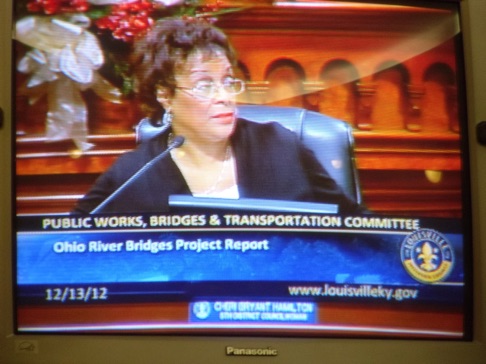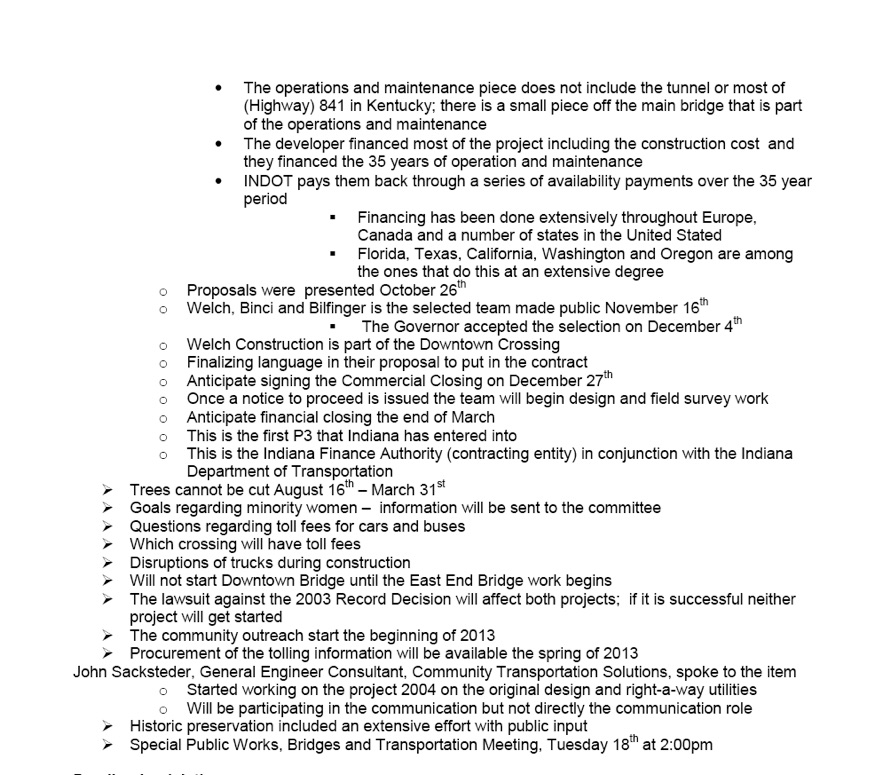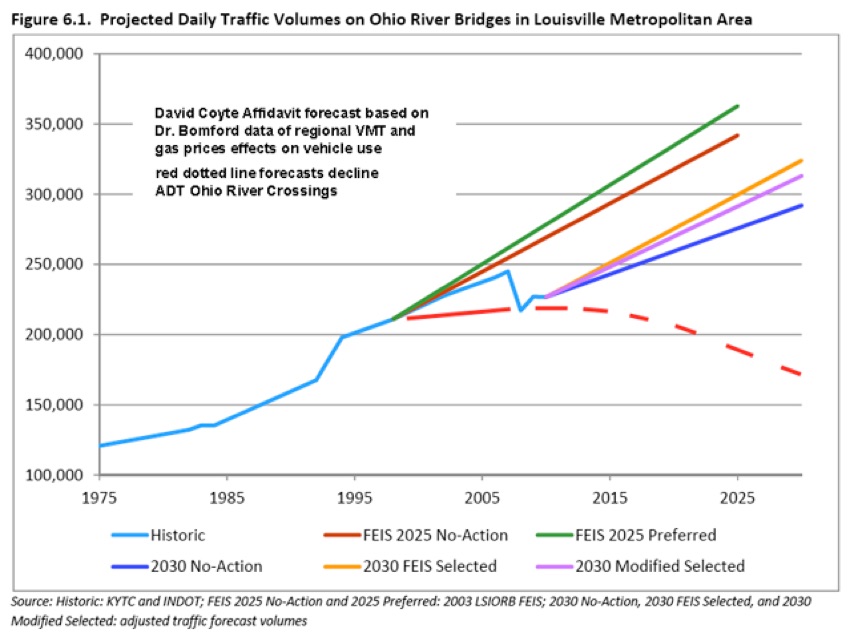December 13, 2012 Louisville, KY
"What's good for the region is good for Louisville."
Councilwoman, Teena Ward Pugh said at the Subcommittee meeting where Ron Heustis and Andy Barber from the two states transportation agencies, sat and gave testimony on the status of the Louisville Bridges Project.
Present were Chair, Cheri Bryant Hamilton, Council members, Tom Owen, Teena Ward Pugh, Robin Engle and Kelly Downard. Jim King was present during some portion.
Evidently whats good for the region, is for the motoring public to pay $ 8.4 billion more than the actual construction costs of $ 1.6 billion, to get the bridges built. According to the selected contractors, which include the Walsh Construction entities for both Downtown and East End Crossings, the Bridges will be finished and open to traffic in three years more or less.
Andy Barber said the Downtown Crossing would cost $ 90 million less than the state’s estimate at $ 860 million, and would be substantially complete on December 10, 2016--three years.
Ron Heustis said the East End Crossing would be complete and open to traffic on October 31, 2016--Drumanard Tunnel included. Heustis announced that tree clearing of 42 acres of Indiana Bat summer maternity habitat would be completed between January and March of this year.
The Bridges Project is the largest project “by ten times” that KYTC has ever let for contract in the state’s history, said Barber. There was some discussion of the $ 20 million to be used for TARC buses, which apparently is just planned to give some mitigation during the construction phase.
The $ 20 million would be 1.2 % of the construction cost of $ 1.6 billion.
But the total revenue from tolling the bridges for 35 years is $ 10 billion.


"What's good for the region is good for Louisville."
Councilman Downard, I can't wait for the day that I stand next to you to cut the ribbon on opening day.
Councilwoman, Teena Ward Pugh, December 13, 2012
Metro Council Subcommittee on Bridges & Transportation

Metro Council Transportation Committee appeared as a cheerleading section for the Bridges Project yesterday and was not keen to ask probing questions of the two state transportation agency members.
The Metro members silently accepted the agencies answer
– that toll rates had not been decided yet and would
be determined later.
– that the tolling policy and make up of the tolling Board would
be determined later.
– that the length of time and the various levels of tolls would
be determined later.
– that some police and emergency class of vehicles would pay
no tolls, but not TARC buses.
No member asked whether we could build an east end bridge first without tolling and then begin to finance the second bridge three years later?
CART members attended and gave the Committee the attached 2012 Bridges Initial Financial Plan Tables showing that because of
the greater traffic volumes, the users of the Kennedy Downtown Crossing would pay gross toll revenue of $ 7.2 billion, while the East End Crossing drivers would pay only $ 2.9 billion in the same 35 year post construction tolling period.
The Downtown Crossing motorists will pay twice the tolls of the East End Crossing drivers.
No questions from metro council on whether we could avoid tolls by sequencing construction.
No questions from Metro Council on whether paying $ 1.3 billion for a toll authority is a good deal.
The Metro Council fills its days debating the wisdom of projects costing a few millions, but when this mega project is before the Courts and the public and threatens to overcharge the driving public some $ 8.4 billion above the actual costs of construction ––
Metro Council seems little concerned.
Estimates of conventionally available funds furnished by the two states demonstrate there is no need to use expensive toll revenue financing to build the bridges. We could pay the contractors for the East End Bridge-outright with available funds. When that construction and disruption is over in three years, we could build a second bridge with appropriate single project financing and remaining available federal and state funding sources.
The table shows that the state and federal funding between 2013 and 2016 alone is $ 793 million--more than enough to buy the East End Bridge outright.
Councilwoman Cheri Bryant Hamilton talking to John Sacksteder of CTS, the General Engineering Contractor for the Bridges Project. David Coyte, CART in foreground



Councilwoman Cheri Bryant Hamilton
Ron Heustis INDOT
The $ 1.3 billion proposed for operation and maintenance of the
TOLLING AUTHORITY rivals the total construction costs of the two bridges. The additional $ 7.1 billion for financing is too bad a deal. By building the bridges in sequence separated by three years, the public purse is spared unnecessary costs in the billions.
Andy Barber answering questions of Tome Owen and Teena Ward Pugh

Why is there a news blackout in the major outlets on the worst highway project deal in Louisville’s history?
Original
cost
estimate
modified
alternative
cost
contractors
bids
A further $ 238 million is already available from 2017 to 2018 to begin financing on the Downtown Crossing. But the delay would allow the Kennedy Bridge to be resurfaced and data from the reduction in congestion of 11% or more from diverted traffic on the east end bridge to be analyzed.
Even if you favor the bridges project . . . do you want to pay $ 10 billion in tolls for $ 1.6 billion in construction?


CART alleges inflated bridge traffic forecasts were used to persuade the public
to agree to be tolled $ 10 billion to build both an East End Bridge and a Downtown Bridge. The Bridges Authority Contractors forecasts gave insufficient consideration of rising gas prices, cost of vehicle ownership, declining incomes and climate change affecting vehicle use. This graph without the red dotted line appeared in the CDM Bridge Traffic Forecast study February 2012.

Wilbur Smith 2003 traffic forecasts
CDM Smith 2012 traffic forecasts
CART 2012 Bridge traffic forecasts
CDM Smith concluded the 2007 downturn was a short term trend